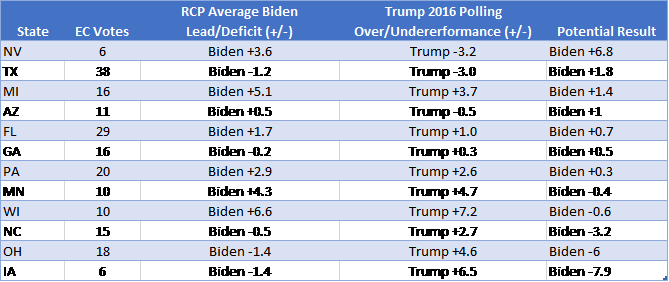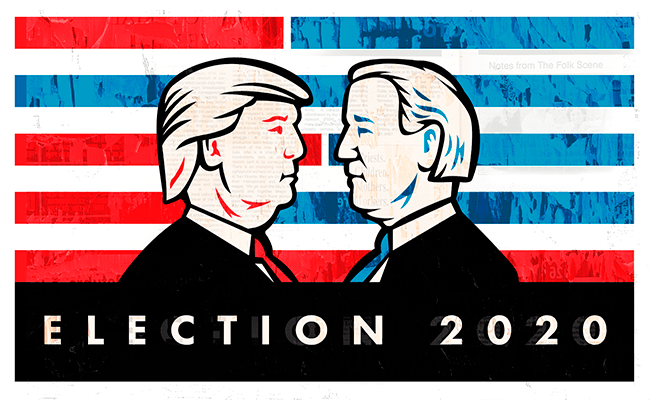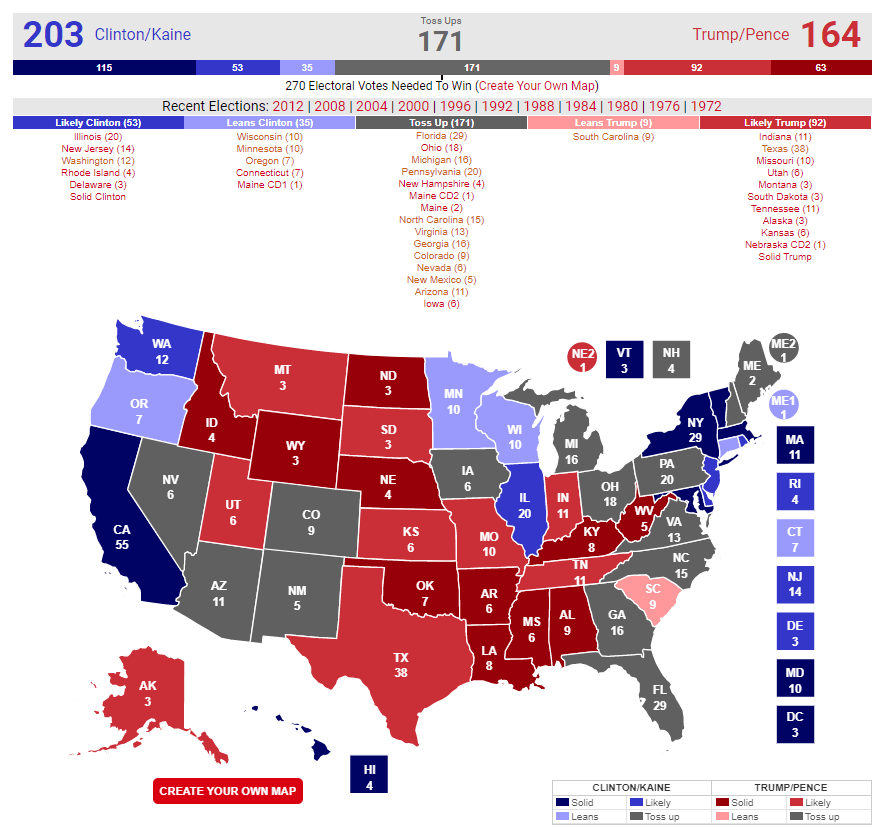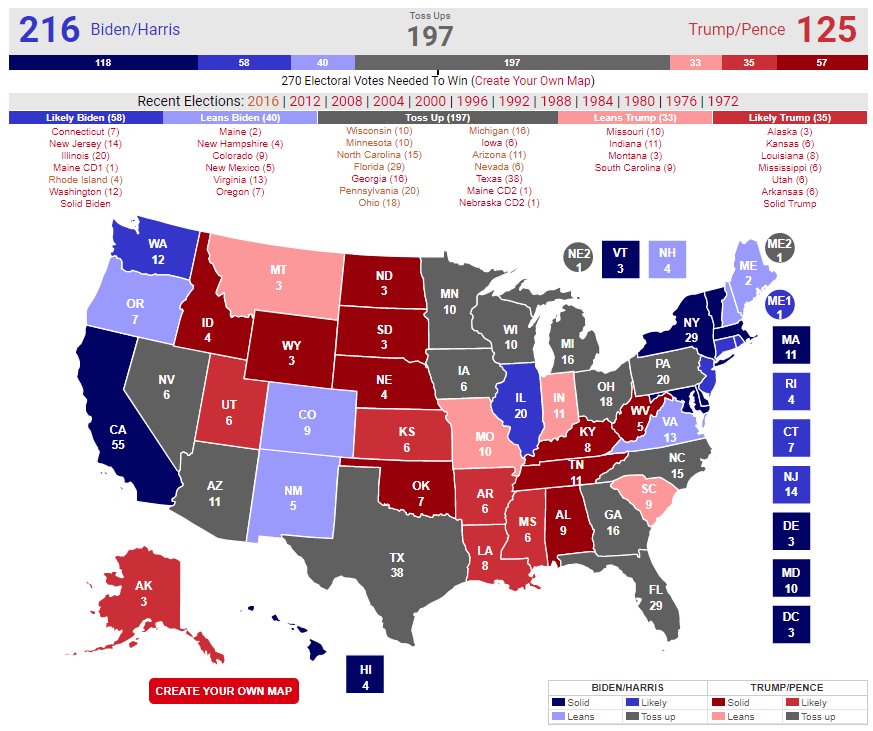If you have followed the polls you know that it is widely expected that Joe Biden will be the next president of the US. Two well-known poll aggregators, FiveThirtyEight and the Economist give Biden a 90% and 97% chance of victory on the eve of the election.
But everyone talks about the 2016 election and how the polls got it all wrong and that you can’t trust them. Below we will discuss why that is not the case and why Biden will win today. Then we will discuss why the polls were wrong, why they can be wrong, and why Trump will win today.
Yes, this is a classic post where I make sure I can’t be wrong. But I am not a pollster, nor do I have any special insight into what will happen today. So instead I will spend time discussing what the numbers say and give both the red and blue teams something to be happy and upset about. And by approaching the analysis with a hypothesis that one candidate or the other will win, I look for data to support that argument and see where the data takes me.
What Happened in 2016
We all are probably aware that polls of the 2016 national popular vote were right on. But we don’t vote that way, we use the famous electoral college and the 270 EC vote threshold to elect presidents. And pundits (and voters) are constantly saying that the polls got it all wrong in 2016 because polls got the states wrong. But this isn’t the case, though the average margin of error was higher in 2016 than in other elections. It seems as though people view polls as numbers that are expected and that the margin of error is just this topline number can explain why Trump won. It can, but just not in the way that is widely discussed.
Let’s look at the 2016 electoral college map on the eve of the 2016 election between Hillary Clinton and Donald Trump. The screenshot below is from RealClear Politics. What you see is that the expectation was that Clinton had 203 electoral college votes that were assumed to be reliably in her column – meaning the polls were favoring Clinton enough that they assigned the EC votes to Clinton. Trump had 164 ‘reliable’ EC votes, and there were 171 votes in states that were considered ‘toss-ups’ – meaning that, while someone held a polling lead in these states, they were too close to assigning as a reliable vote for either Trump or Clinton.
Source: RealClear Politics
The 3 states that everyone remembers being ‘wrong’ are primarily Pennsylvania, Wisconsin, and Michigan. But really, only Wisconsin was wrong. This state was assumed safe enough for Clinton that they put it in the blue column and she lost there. The aggregate of polls had her up 6.5% and she lost by 0.7%. So definitely wrong. But it didn’t matter. Meaning that if you gave Clinton the 10 EC votes from Wisconsin, she still would have lost. Clinton would have lost even if she won Wisconsin and either Michigan or Pennsylvania.
In MI, Clinton was up 3.4% in the final polling averages, and Trump won by 0.3%. And in PA, Clinton was leading the aggregate poll by 1.9% and she lost by 0.7%. And that is why these states were toss-up states, the polling averages were too close to assigning to Clinton when Trump was within striking distance. It is more a case that people didn’t want to believe that Trump could get elected and assumed that the lead in the polls would result in a win at the polls. That is the real error.
And yes, there were other states where there were polling errors, but none so significant that it altered the winner – meaning that if Trump was predicted to win a state, he won it, even if the error was greater than expected. While Minnesota had a 4.7% error in favor of Trump, Clinton still won the state and the EC votes that go along with it. So other than Wisconsin, there were no polling errors that impacted the results, only poll reading errors.
Biden by a Landslide
Let’s look at the same map from RealClear Politics on the eve of the 2020 election. The race has tightened a bit in the closing days, as often happens, but Biden holds a lead in the electoral college ‘safe’ votes of 216 to 125 for Trump with 197 EC votes rated ‘toss-up’.
Source: RealClear Politics
To start, Biden is a bit closer to the magical 270 EC votes required than Clinton was in 2016, and Trump 2020 is trailing Trump 2016 by 39 EC votes, mostly a result of Texas’ new ‘toss-up’ status (plus NE-2 going to toss-up). But the real information is in looking under the hood at the state polls. As a baseline, if we assume that Biden holds his lead in all the states where he is polling ahead, he would add 102 EC votes to his 216 “safe” EC votes to get well over the additional 54 EC votes needed to get to 270.
But let’s note that the polls in 2016 generally (but not universally as you will see) undercounted Trump’s support. And let’s assume that the pollsters have learned nothing in 4 years and that the polls are undercounting the Trump vote by the same margin as in 2016. If we do that we get an additional 136 EC votes for Biden. Yes, you read correctly, if errors are assumed to be exactly as they were in 2016, Biden would win by more than if the polls just hold. Because what can help Trump, can also hurt him. Polls overstated Trump’s lead in states like Texas, and those EC votes would go to Biden if 2016 errors hold for 2020. And so would Georgia.
 Source: RealClear Politics 2020 and 2016 state polling averages against 2016 actual results.
Source: RealClear Politics 2020 and 2016 state polling averages against 2016 actual results.
The bottom line is there are many paths to a Biden victory. Even if you assume TX and GA will stay in Trump’s column (which wouldn’t surprise anyone), while Trump keeps MI and MN (with the errors), that still wouldn’t get him to 270 and Biden would still win.
Another reason Biden will win by a landslide is that the early voting has been off the charts, and those voters are widely reported to favor Biden. While Trump’s supporters are expected to turn out in higher numbers on election day, it will likely not be enough to counter the early advantage. I would always take supporters that have voted already over voters that are going to vote. Things happen, there is a pandemic that is getting worse by the day, and you can’t count a vote until it is cast. Asking older voters, the most vulnerable to Covid and the most reliable voting block for Trump, to go stand in long lines with strangers on election day is a risky strategy. Plus, Trump hasn’t expanded his support in 4 years and won by razor-thin margins, so more voters are probably not good for him.
Trump Wins a Second Term
Just a week ago, RCP had Biden with a baseline assumption of 236 EC votes. MN and WI have changed from safe to toss-up, and now only 216 EC votes are considered likely to go to Biden. The momentum is going in Trump’s direction. There is no way that TX and GA vote Biden, and FL, with the high percentage of older voters, is likely to go to Trump too. Not to mention Ohio, Iowa, and North Carolina, all polling as Trump victories. With those states, Trump gets to 247 EC votes. Then all Trump has to do is hold two of the states he won in 2016: AZ, WI, MI, and PA, all within the margin of error, and it is game over.
Adding to the likelihood of Trump winning Florida is that Biden is reportedly having trouble winning over Latinos in the state. Without the Latino vote, Biden probably can’t win Florida. Trump’s map to victory could be very similar to 2016 where he won 306 EC votes, and there don’t need to be any polling errors for him to do it. He would have won 2016 without the WI polling error, so he didn’t win his first term on a fluke.
And the election odds at the top of this article? Nearly meaningless. Clinton had a 71% chance of winning according to the 2016 odds. She was heavily favoured too, and as discussed, not much had to go wrong for Clinton for her to lose.
Finally, have you ever seen a candidate elicit so much emotion on both sides? I would venture to say that while Biden certainly has his supporters, a lot of people voting for Biden are casting votes against Trump – meaning that they would vote for absolutely anyone else and it is irrelevant that Biden is on the ballot. That’s not the position of a winner. Meanwhile, Trump voters are enthusiastically voting for Trump. Protest voters are voters that may stay home, while enthusiastic people will make it to the polls to vote. The tremendous Trump enthusiasm will more than make up any differences in polling aggregates. And that enthusiasm is likely understated in the early voting expectations, which would mean that there isn’t nearly as much ground to make up on election day.
So while the paths to a Trump victory aren’t as diverse as Biden’s, they are not out of the realm of possibility based on past voting preferences and current polling averages. And they are certainly not out of the realm of possibility given what happened in the last election.
The Bottom Line
Based on the data, I believe that Biden will win the 2020 election. We don’t have real 3rd party candidates this year, and Gary Johnson and Jill Stein siphoned some votes from somewhere in 2016. Given Clinton’s unpopularity, I have little doubt that people cast a vote for someone other than Clinton, without voting for Trump. That could have worked the other way too, but this year we have a straight-up horse race.
And while in 2016 there was a healthy portion of voters who were undecided going into the election, there certainly aren’t as many in 2020. With voting records being broken in 2020, and Trump’s approval ratings being mired in the ’40s and lower for his entire presidency, and getting poor marks for his handling of the pandemic that is getting worse as Fall progresses, he is not a position of power going into the election. So I won’t be shocked if Trump wins, but the data points to Biden at this point.






